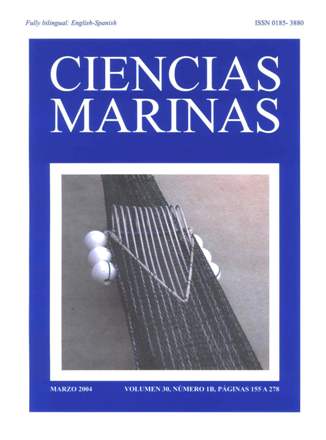Visual assessment of the coastal fish assemblages from the area of the proposed Gando-Arinaga Marine Reserve (Gran Canaria, Canary Islands)
Main Article Content
Abstract
Eighty-eight visual assessments (5-min stationary censuses in an area of 200 m2) were made during the winter of 1999|00E2|??2000 and summer of 2000 in the area of the proposed Gando-Arinaga Marine Reserve (Gran Canaria, Canary Islands), in order to optimize a technique for the visual evaluation of the fish assemblages, describe the situation and environmental factors that structure the fish community, and determine the influence of the different protection categories defined on the abundance and size of certain species of interest to fisheries. A total of 36 fish species were observed. The most frequent (frequency of occurrence >50%) were Abudefduf luridus, Thalassoma pavo, Chromis limbatus, Sparisoma cretense and Diplodus vulgaris, while the most abundant (mean abundance per census >5 ind 100 m–2) were Pomadasys incisus, Boop boops, A. luridus, C. limbatus and T. pavo. The mean number of species per census varied between 18.25 and 3.5 (mean = 7.61). The mean number of individuals varied between 382.62 and 2.75 (mean = 94.43). Diversity (H′) was low (0.88–0.22, mean = 0.52) and evenness (J′) ranged from 0.33 to 0.94 (mean = 0.64). Differences in abundance and size among the different zones defined were not detected for S. cretense whereas differences in size but not in abundance were detected for Mullus surmuletus and Diplodus sargus. Differences were not found for the biotic descriptors of the fish community in terms of seasonality, but differences were found relative to habitat. Multivariate techniques showed that substrate slope and depth are the most important abiotic factors structuring the community. Species richness and total abundance of individuals increased with depth and slope, whereas evenness decreased.
Downloads
Article Details
This is an open access article distributed under a Creative Commons Attribution 4.0 License, which allows you to share and adapt the work, as long as you give appropriate credit to the original author(s) and the source, provide a link to the Creative Commons license, and indicate if changes were made. Figures, tables and other elements in the article are included in the article’s CC BY 4.0 license, unless otherwise indicated. The journal title is protected by copyrights and not subject to this license. Full license deed can be viewed here.

